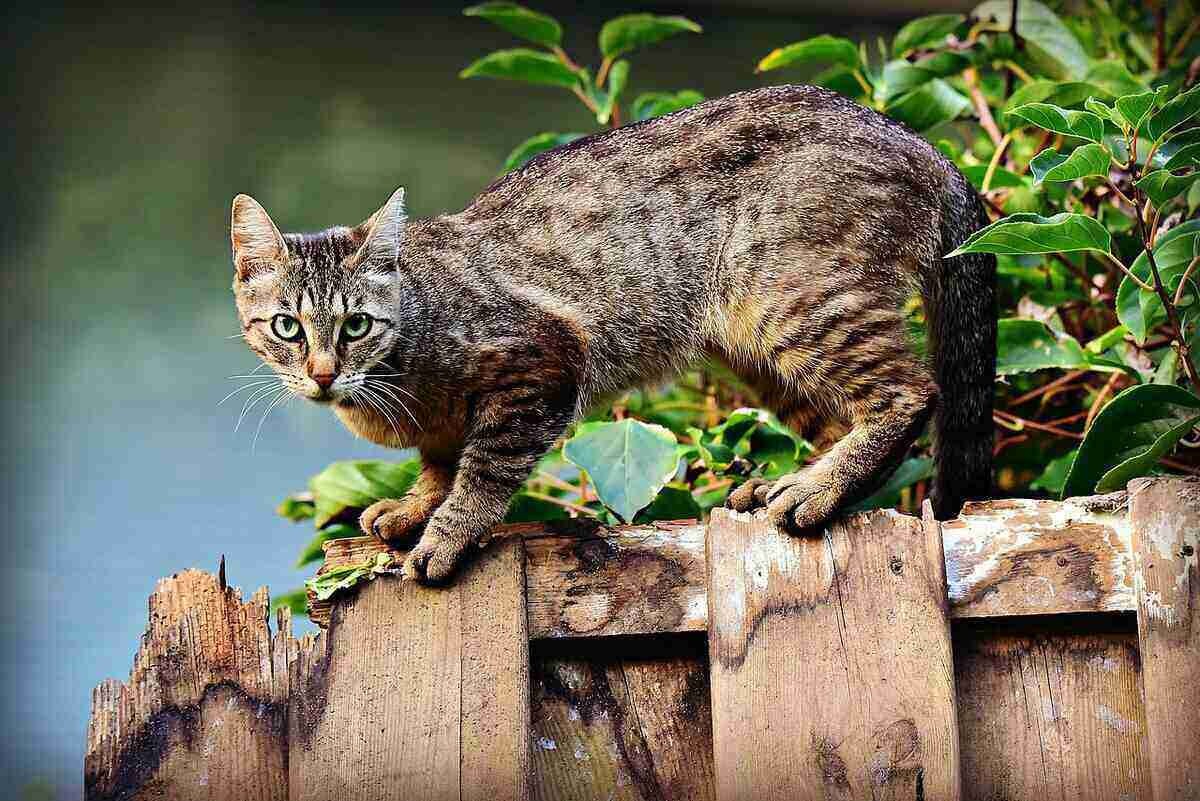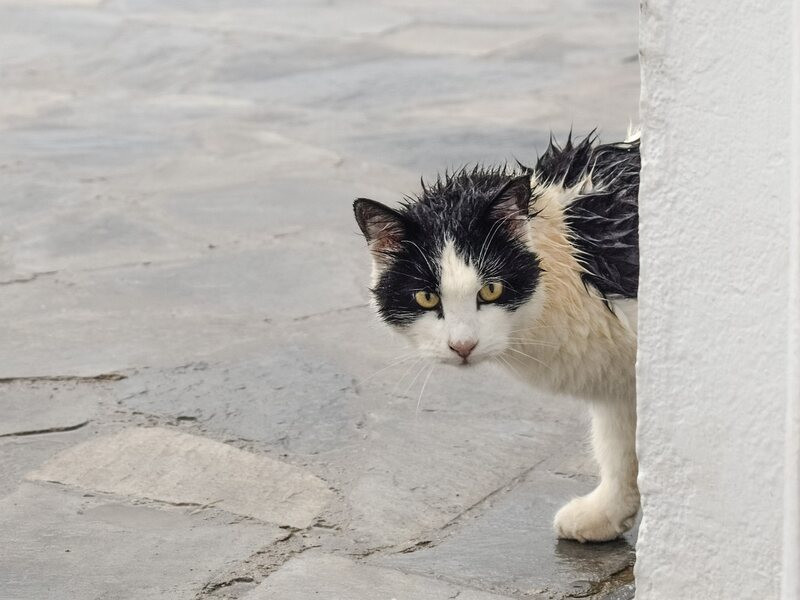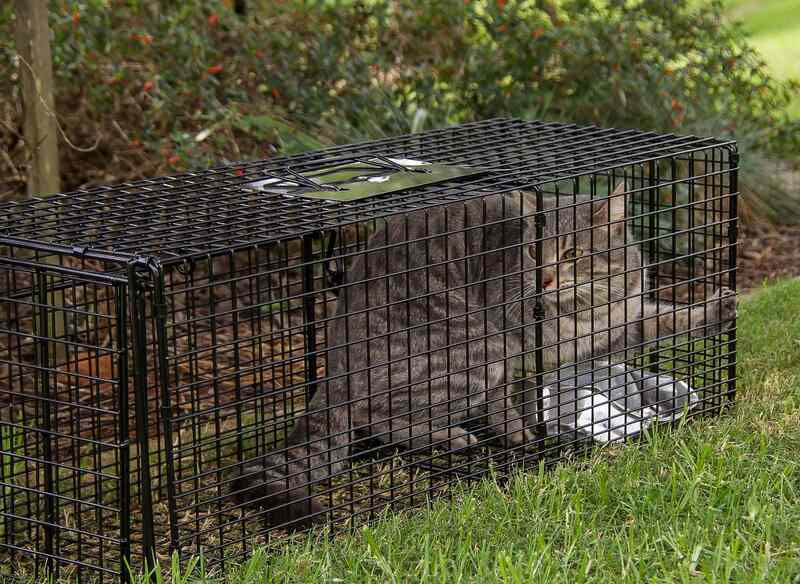Keeping cats out of your yard can be achieved without harming them; How To Keep A Cat Out Of My Yard is a common question among homeowners seeking to protect their gardens and pets. Solcat.net offers humane and effective strategies for creating a cat-free zone, including scent repellents, physical barriers, and community-based solutions, ensuring a peaceful coexistence with neighborhood felines. To explore a wealth of information on feline behavior, pet-friendly gardening tips, and effective cat deterrents, visit solcat.net today!
1. Understanding Why Cats Visit Your Yard
Before implementing any strategies, understanding why cats frequent your yard is crucial. You might be unknowingly attracting them with food sources or providing appealing shelter.
- Food Sources: Cats are drawn to yards with easy access to food. This includes uncovered trash cans, pet food left outdoors, or even bird feeders attracting prey.
- Shelter: Cats seek out safe, sheltered spots to hide from predators or the elements, such as under decks, in crawl spaces, or within dense shrubbery.
Eliminating these attractants is the first step in discouraging cats from entering your property.
1.1 Removing Food Sources
To deter cats effectively, start by removing or securing any potential food sources.
- Secure Trash Cans: Use trash cans with tight-fitting lids and consider securing them with bungee cords to prevent cats (and other animals) from accessing the contents.
- Avoid Leaving Pet Food Outside: Feed your pets indoors and promptly remove any leftover food.
- Monitor Bird Feeders: Bird feeders can attract cats looking for prey. If cats are a problem, consider temporarily removing bird feeders or using cat-proof feeders that prevent cats from reaching the birds.
1.2 Blocking Access to Hiding Spots
Cats are attracted to dark, secluded areas where they can feel safe. Blocking access to these areas can make your yard less appealing.
- Install Barriers: Use chicken wire, lattice, or solid fencing to block access to crawl spaces, under decks, and other potential hiding spots.
- Regular Maintenance: Regularly inspect your yard for new hiding spots and take steps to block them off.
 Cat peeking through fence slats, exploring the yard
Cat peeking through fence slats, exploring the yard
2. Utilizing Scent Repellents
Cats possess a highly developed sense of smell, making them sensitive to certain odors that can deter them from entering your yard.
- Commercial Repellents: Several commercial cat repellent sprays are available, formulated with scents that cats find unpleasant.
- Natural Repellents: Various natural scents can effectively repel cats, offering an eco-friendly alternative.
Experiment with different scent repellents to determine which works best for the cats in your area, keeping in mind that reapplication is often necessary to maintain effectiveness.
2.1 Commercial Cat Repellents
Commercial cat repellents offer a convenient and often effective way to deter cats from your yard.
- PetSafe SSSCAT Spray: This motion-activated spray emits a harmless burst of air when a cat approaches, startling them and discouraging them from entering the area.
- Nature’s Miracle Just for Cats Pet Block: This spray uses a blend of scents that cats find unpleasant, deterring them from spraying, scratching, and entering treated areas.
2.2 Natural Scent Repellents
Natural scent repellents provide an environmentally friendly and cost-effective way to keep cats away.
- Citrus Peels: Scatter fresh citrus peels (orange, lemon, grapefruit) around your garden or yard. Cats dislike the strong citrus scent.
- Coffee Grounds: Spread used coffee grounds around plants or in areas where cats frequent. The strong smell deters them, and the grounds also act as a natural fertilizer.
- Tea Leaves: Similar to coffee grounds, used tea leaves can be scattered around your yard to repel cats.
- Vinegar: Spray a diluted vinegar solution (equal parts vinegar and water) in areas where you want to deter cats. Be careful not to spray directly on plants, as vinegar can harm them.
- Essential Oils: Mix a few drops of essential oils like lavender, citronella, lemongrass, or eucalyptus with water in a spray bottle and apply around your yard. These scents are generally disliked by cats.
- Blood Meal: Blood meal is a dried blood product that cats find repulsive. It can be added to the soil around plants to deter digging and also acts as a fertilizer.
Table: Effectiveness and Considerations for Natural Scent Repellents
| Scent | Effectiveness | Considerations |
|---|---|---|
| Citrus Peels | Moderate | Need to be replaced regularly as they dry out. |
| Coffee Grounds | Moderate | Can stain surfaces; avoid using on light-colored materials. |
| Tea Leaves | Moderate | Similar to coffee grounds, can stain surfaces. |
| Vinegar | High | Can harm plants if applied directly; dilute with water and avoid spraying on foliage. |
| Essential Oils | Moderate | Some essential oils can be toxic to pets if ingested; use caution and ensure cats cannot directly access treated areas. |
| Blood Meal | High | Can attract other animals; use sparingly and mix into the soil. |
{width=800 height=533}3. Planting Cat-Repelling Plants
Certain plants possess natural scents that cats dislike, making them a valuable addition to your garden for deterring feline visitors.
- Rosemary: This fragrant herb is known to repel cats with its strong scent.
- Curry Plant: The distinctive aroma of the curry plant is unpleasant to cats, making it an effective deterrent.
- Lemon Thyme: This herb emits a citrusy scent that cats dislike, helping to keep them away from your garden.
3.1 Safe and Effective Plant Choices
When selecting cat-repelling plants, it’s essential to prioritize safety for both humans and pets.
- Rosemary: Rosemary is a safe and effective choice, offering a pleasant aroma for humans while deterring cats.
- Curry Plant: While effective at repelling cats, the curry plant can be toxic if ingested in large quantities, so it’s best to plant it in areas where cats are less likely to nibble on it.
- Lemon Thyme: Lemon thyme is generally safe and well-tolerated, making it a good option for gardens frequented by pets and children.
Important Note: Always research plants thoroughly before introducing them to your garden, especially if you have pets or children. Some plants commonly recommended as cat repellents can be toxic if ingested or cause skin irritation upon contact.
3.2 Plants to Avoid
Several plants commonly recommended for repelling cats can be harmful to humans and pets.
- Pennyroyal: Highly toxic to humans and pets if ingested.
- Rue: Causes severe skin irritation in humans and pets.
- Scaredy-Cat Plant (Coleus Canina): Causes severe skin and stomach irritation in pets.
- Lavender: Toxic if ingested by pets.
- Geraniums: Toxic if ingested by pets.
- Citronella: Toxic if ingested by pets.
- Lemongrass: Toxic to pets if ingested in large quantities (cats are more sensitive to this one than dogs).
4. Creating Uncomfortable Surfaces
Cats prefer soft, comfortable surfaces for lounging and digging. By making potential hangout spots less appealing, you can discourage cats from lingering in your yard.
- Carpet Runners: Place plastic carpet runners with the spike side up in your flower beds or other areas where cats like to lounge. The spikes will not harm the cats but will make the surface uncomfortable.
- CatScat Mats: These mats have flexible plastic spikes that deter cats without causing harm.
- Chicken Wire: Cover the ground in your garden with chicken wire to prevent digging. Roll the sharp edges under to prevent injury.
- Plastic Netting: Similar to chicken wire, plastic bird netting can be laid on the ground to deter digging.
- Sharp Mulch: Use rough-edged mulch, such as crushed eggshells, pine cone pieces, or rough rocks, to make digging uncomfortable.
- Sticks, Stakes, and Cutlery: Insert branches, chopsticks, forks, or garden stakes into the soil to make it difficult for cats to lounge comfortably.
4.1 Implementing Physical Barriers
Physical barriers can effectively prevent cats from accessing specific areas of your yard.
- Fencing: Install fences around your garden or property to create a physical barrier that cats cannot easily cross.
- Netting: Use netting to protect vulnerable plants and prevent cats from digging in flower beds.
4.2 Modifying Existing Surfaces
Altering the texture of surfaces can make them less appealing to cats.
- Rough Mulch: Use rough-edged mulch in garden beds to deter digging.
- Pebbles and Rocks: Cover surfaces with pebbles or rocks to make them less comfortable for lounging.
5. Utilizing Ultrasonic Animal Repellers
Ultrasonic animal repellers emit high-frequency sounds that are inaudible to humans but irritating to cats and other animals.
- Placement: Place the devices around the perimeter of your property or in areas where cats are frequently seen.
- Outdoor Use: Ensure the device is designed for outdoor use and is effective for larger pests like cats.
- Pet Safety: Turn off the device before letting your own pets outside, as the sound can also irritate them. Note that the sound does not penetrate walls and will not bother indoor pets.
5.1 How Ultrasonic Repellers Work
Ultrasonic repellers emit high-frequency sound waves that are beyond the range of human hearing but are irritating to cats and other animals. These sounds disrupt the animals’ comfort and encourage them to avoid the area.
5.2 Choosing the Right Device
When selecting an ultrasonic animal repeller, consider the following factors:
- Range: Choose a device with a sufficient range to cover the area you want to protect.
- Weather Resistance: Ensure the device is weather-resistant to withstand outdoor conditions.
- Adjustable Settings: Look for devices with adjustable frequency and sensitivity settings to customize the coverage for your specific needs.
6. Employing Motion-Activated Sprinklers
Cats generally dislike water, making motion-activated sprinklers an effective deterrent.
- Placement: Position sprinklers around the perimeter of your property or in areas where cats are frequently seen.
- Coverage: Adjust the sprinkler settings to ensure adequate coverage of the targeted area.
- Seasonal Considerations: Be aware that motion-activated sprinklers may not function properly in freezing temperatures.
6.1 How Motion-Activated Sprinklers Work
Motion-activated sprinklers use sensors to detect movement within a specific range. When an animal, such as a cat, enters the sensor’s range, the sprinkler emits a burst of water, startling the animal and encouraging it to leave the area.
6.2 Maximizing Effectiveness
To maximize the effectiveness of motion-activated sprinklers:
- Strategic Placement: Place sprinklers in areas where cats are frequently seen, such as garden beds, pathways, and entry points to your yard.
- Adjustable Sensitivity: Adjust the sensitivity settings to avoid triggering the sprinkler unnecessarily.
- Regular Maintenance: Regularly check and maintain the sprinklers to ensure they are functioning properly.
 A wet cat looking surprised near a corner, caught off guard by a sprinkler
A wet cat looking surprised near a corner, caught off guard by a sprinkler
7. Installing Cat-Proof Fencing
Traditional fences may not be sufficient to keep cats out of your yard, as they are skilled climbers and jumpers. Cat-proof fencing offers a more secure solution.
- Slanted Wire Panel: Install a slanted wire panel or chain link along the top of your existing fence, angled outward to prevent cats from climbing over.
- Cat Fence Roller: Install a rolling bar on top of your existing fence. When cats attempt to jump and grab the top of the fence, the rolling bar prevents them from getting a solid hold.
7.1 Types of Cat-Proof Fencing
Several types of cat-proof fencing are available, each with its unique design and benefits.
- Slanted Wire Panel: This type of fencing features a wire mesh panel that is angled outward at the top of the fence, preventing cats from climbing over.
- Cat Fence Roller: This system consists of a rolling bar that is installed along the top of the fence. When a cat attempts to jump and grab the top of the fence, the rolling bar spins, preventing the cat from getting a secure grip.
- Electric Fencing: Electric fencing delivers a mild, harmless shock to deter cats from approaching the fence.
7.2 Considerations for Installation
When installing cat-proof fencing, consider the following factors:
- Fence Height: Ensure the fence is tall enough to prevent cats from jumping over it.
- Material: Choose a durable, weather-resistant material that can withstand outdoor conditions.
- Installation: Follow the manufacturer’s instructions carefully to ensure proper installation.
8. Considering TNR (Trap-Neuter-Return) Programs
If your neighborhood has a large population of feral cats, TNR programs can be an effective long-term solution.
- Trap: Humanely trap community cats using wire traps.
- Neuter: Take the cats to a vet to be spayed or neutered and vaccinated. The vet will also clip the tip of the cat’s ear as a universal symbol that the cat has been TNRed.
- Return: Release the cats back into their territory.
TNR programs help control the feral cat population, reduce unwanted behaviors like spraying and yowling, and prevent the spread of rabies.
8.1 How TNR Programs Work
TNR programs involve trapping feral cats, sterilizing them, and returning them to their original habitat. This approach helps to stabilize feral cat populations, reduce nuisance behaviors, and improve the overall health and well-being of the cats.
8.2 Benefits of TNR Programs
TNR programs offer numerous benefits for both communities and feral cats.
- Population Control: TNR programs help to control the feral cat population by preventing reproduction.
- Reduced Nuisance Behaviors: Sterilized cats exhibit fewer nuisance behaviors, such as spraying, yowling, and fighting.
- Improved Health and Well-being: TNR programs often include vaccinations and medical care, improving the overall health and well-being of feral cats.
- Community Benefits: TNR programs can help to reduce shelter intake, euthanasia rates, and complaints from residents.
 A cat inside a humane trap, part of a TNR program
A cat inside a humane trap, part of a TNR program
9. Weighing the Benefits of Cats in Your Yard
Before completely evicting cats from your yard, consider the potential benefits they may offer.
- Pest Control: Cats are natural hunters and can help control populations of mice, rats, and other small pests.
- Natural Balance: Cats can contribute to the natural balance of your yard ecosystem by preying on pests and preventing overpopulation.
9.1 The Role of Cats in Pest Control
Cats are natural predators and can effectively control populations of rodents and other small pests. Their presence in your yard can help to reduce the need for chemical pest control methods.
9.2 Balancing Act: Managing Cats and Protecting Your Property
You can protect your garden and outdoor living spaces from cats while still allowing them to roam the wider property. Exclusion methods can be used to keep cats out of specific areas, while still allowing them to benefit your yard as natural pest controllers.
FAQ About Keeping Cats Out of Your Yard
Here are some frequently asked questions about keeping cats out of your yard:
Can I take neighborhood cats to the shelter?
While it may be tempting to take stray cats to the shelter, it is generally not the best solution. Shelters are often overcrowded, and many animals are euthanized. Outdoor cats can live long and happy lives outdoors, and there are many humane ways to coexist with them.
Do mothballs repel cats?
Mothballs are not an effective or humane cat repellent. They are toxic to cats and other animals and can also harm the environment.
Is cayenne pepper a good cat deterrent?
Cayenne pepper is not a humane cat deterrent. It can cause intense burning and stinging if it comes into contact with a cat’s eyes, nose, or skin.
What can I do to keep my cat from roaming the neighborhood?
If you are a cat owner looking to keep your cat from roaming the neighborhood, there are several steps you can take.
- Cat-Proof Fencing: Install cat-proof fencing to keep your cat contained within your yard.
- Regular Feeding: Feed your cat on a regular schedule and in the same location every day so they don’t wander in search of food.
- Outdoor Shelter: Provide outdoor shelters on your property where your cat can hide and shelter from cold weather.
- Outdoor Litter Boxes: Create outdoor litter boxes to encourage your cat to use them instead of your neighbor’s garden bed.
How can I prevent other unwanted animals in my yard?
Many of the techniques used to deter cats can also help discourage other animals.
- Eliminate Food and Water Sources: Remove any potential food and water sources to make your yard less appealing to animals.
- Fencing: Install tall fencing with no gaps and an underground portion or barrier to prevent digging.
- Deterrents: Use scent, texture, and plant deterrents to discourage animals from entering your yard.
What are some effective commercial cat repellents?
Some popular and effective commercial cat repellents include PetSafe SSSCAT Spray and Nature’s Miracle Just for Cats Pet Block. These products use scents or mechanisms that cats find unpleasant to deter them from entering treated areas.
Are there any plants that attract cats?
Yes, some plants, like catnip (Nepeta cataria), are highly attractive to cats due to a chemical called nepetalactone, which stimulates their senses. Silvervine (Actinidia polygama) and valerian (Valeriana officinalis) also have similar effects on cats. If you want to keep cats out of your yard, avoid planting these.
How often should I reapply scent repellents?
The frequency of reapplication depends on the type of repellent used. Commercial sprays typically provide instructions on the label, but natural repellents like citrus peels or coffee grounds need to be replaced more frequently, about once a week or after heavy rain.
What are the signs that a cat is marking its territory in my yard?
Cats mark their territory by spraying urine, which has a distinct, strong odor. You might also notice scratching on trees or fences. These are visual and olfactory cues that cats use to communicate their presence to other cats.
Is it safe to use mothballs as a cat repellent?
No, it is not safe to use mothballs as a cat repellent. Mothballs contain chemicals that are toxic to cats and other animals if ingested or inhaled. They also pose an environmental hazard and should be avoided.
Table: Comparing Cat Deterrent Methods
| Method | Effectiveness | Considerations |
|---|---|---|
| Scent Repellents | Moderate | Need regular reapplication; effectiveness varies by cat. |
| Cat-Repelling Plants | Moderate | May not deter all cats; some plants can be toxic. |
| Uncomfortable Surfaces | High | Can be unsightly; may not be suitable for all areas. |
| Ultrasonic Animal Repellers | Moderate | May not be effective for all cats; can be expensive. |
| Motion-Activated Sprinklers | High | Requires water source; may not work in freezing temperatures. |
| Cat-Proof Fencing | High | Can be expensive and require professional installation. |
| TNR Programs | Long-term | Requires community involvement and funding. |
How to Deal With Landscaping Damage Caused by Cats
Cats can sometimes cause damage to lawns and gardens. If you’re struggling to manage the impact of cats on your landscaping, consider contacting local lawn care or gardening professionals.
Solcat.net is a valuable resource for cat lovers and those seeking to coexist peacefully with neighborhood felines. For more information on cat behavior, care tips, and effective deterrents, visit solcat.net today!
Contact Us:
- Address: 950 Alaskan Way, Seattle, WA 98104, United States
- Phone: +1 (206) 386-4000
- Website: solcat.net

